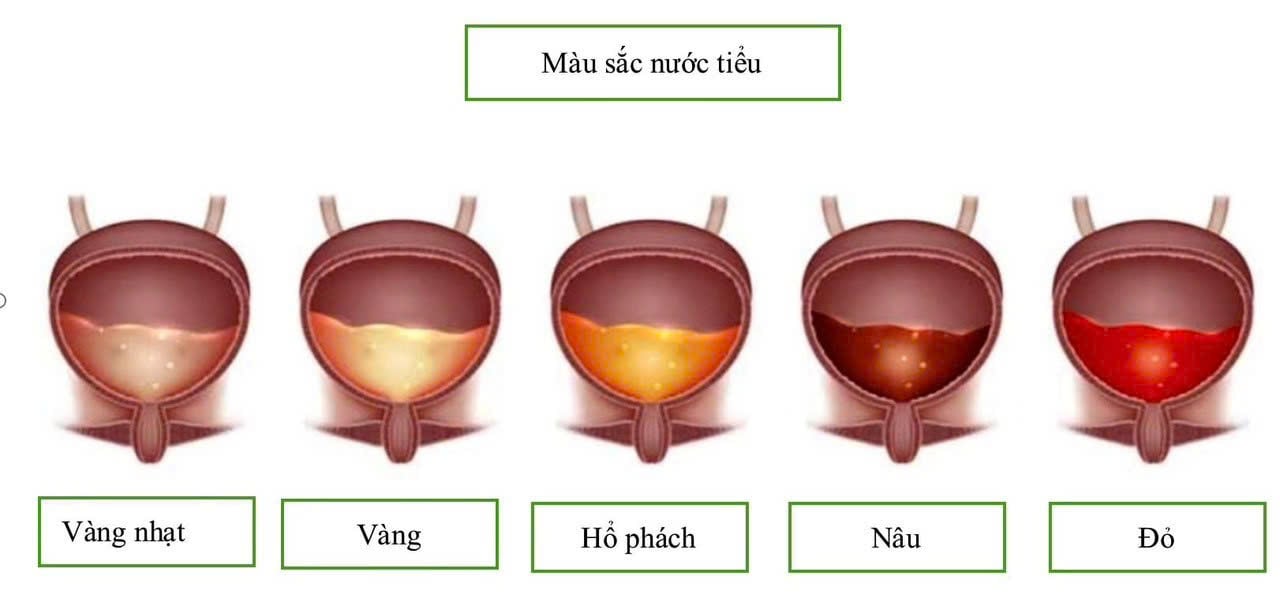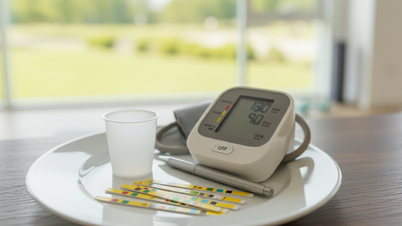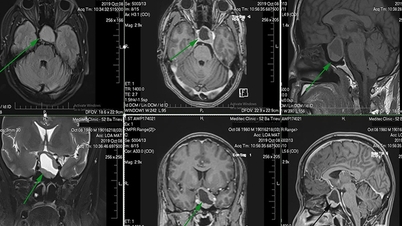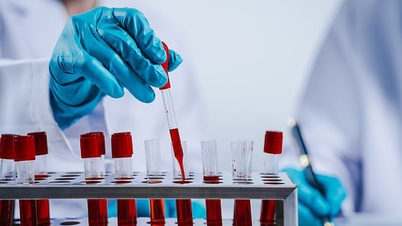
Urine color can reflect health status - Photo: Viet Duc Hospital
Dr. Nguyen Thi Thuy, deputy head of the kidney dialysis department (Viet Duc Friendship Hospital), said that urine testing is one of the simple ways to support non-invasive testing and health monitoring.
Each person can also detect abnormalities in urine through smell, color, and clarity.
According to Dr. Thuy, normal urine ranges from clear to slightly cloudy. Cloudy urine contains bacteria, fat, red blood cells, white blood cells, or changes in urinary pH. Cloudy urine can be caused by vaginal secretions.
What does urine color and smell warn about for the body?
Normally urine is clear yellow, if diluted it is light yellow, if concentrated it will be dark yellow.
But if the urine is red, it can be a sign of urinary tract infection, renal vascular malformation, kidney trauma, kidney tumor; due to medication (eg rifampicin, rifabutin...); due to food (radish, red dragon fruit).
Brown color can be due to the presence of hemoglobin, myoglobin (a protein). Dark yellow color needs attention due to bilirubin index (yellow pigment produced during the process of red blood cell breakdown) or tetracycline.
Cloudy white urine can be caused by a lot of protein (glomerular damage), pus, crystals, and chyle. Finally, light blue/dark blue urine can be caused by urinary tract infection or medication (methylene blue, cimetidine).
It is normal for urine to have a strong odor after a period of urination. However, if the urine has a sweet, fruity odor, it may be due to ketones in the urine.
Foul-smelling urine can be a sign of a urinary tract infection. A fishy smell immediately after urination can be a sign of a urinary tract infection caused by proteus (bacteria that normally live in the intestines). A musty smell can be caused by foods such as asparagus and garlic.
Regarding the amount of urine every day, doctors say that normal people drink enough water, urinating about 1,500ml - 2,000ml/day.
Dr. Thuy added that the urine test aims to detect and measure different compounds passing through the patient's urine using a single urine sample. Through the test results, it will help diagnose many diseases or find the cause of the disease.
"Urine tests should be performed during regular health check-ups. Especially when you notice any unusual signs in your urine, you should see a urologist for proper examination and treatment to avoid affecting your health and life," Dr. Thuy emphasized.

Urine tests should be performed during routine health check-ups - Illustration photo
Meaning of urine test indicators
Bachelor of testing Nguyen Thi Khuyen, Department of Central Testing - Pathology ( Bac Ninh Obstetrics and Pediatrics Hospital), said that normally urine index will be shown through some basic indexes such as red blood cells, white blood cells, and urine specific gravity.
Based on this index, the specific gravity of urine can be known. From there, the doctor can know whether the patient's urine is currently diluted or concentrated when the patient drinks a lot of water or lacks water.
The normal SG index is around 1.015 - 1.025. Through this index, kidney diseases such as pyelonephritis, renal tubular disease; liver disease; diabetes... can be assessed.
- LEU or BLO (Leukocytes) index - white blood cells : This index indicates whether the urine contains white blood cells or not. Normally, white blood cells do not appear in urine. However, if the white blood cell index is positive, it means the patient is at risk of urinary tract infection.
- Nitrite index (NIT) - a compound produced by bacteria : If health is normal, the NIT index will be negative. This is an index that indirectly shows the presence of urinary tract bacteria through the products it produces. The bacteria that often cause urinary tract infections are E. Coli.
- pH index - urine acidity : The pH index is used to assess the acidity - alkalinity of urine. For normal people, the pH index will be from 4.6 - 8. If the pH is less than or equal to 4, it means the urine is highly acidic. A pH index higher than or equal to 9 indicates that the urine is strongly alkaline.
Abnormal urine pH test results can indicate kidney infection, kidney failure, vomiting, pyloric stenosis, diabetes, dehydration, diarrhea, etc.
Urine pH is also related to diet. Vegetarians tend to have high pH, while people who eat a lot of protein tend to have low pH.
- BLD (Blood) index - hematuria : Normally there are no hematuria in urine. However, if this index appears, it is possible that the patient has a urinary tract infection, bladder bleeding or kidney tumor, kidney stones...
When the results of the urine hematuria test are abnormal, the doctor will prescribe additional methods to diagnose organ damage that causes blood in the urine such as the kidneys, bladder, urethra, etc.
- PRO (Protein) index : Normal people will not have protein index in urine. The appearance of a small amount or a small amount of protein in urine indicates the risk of kidney disease, which can cause urinary tract infections or diseases that cause bloody urine.
For pregnant women, protein index is often used to monitor and diagnose some diseases early. Such as high blood pressure, pre-eclampsia, sepsis...
If PRO appears in the urine as albumin, pregnant women need to pay attention to the risk of pregnancy poisoning or gestational diabetes.
- GLU (Glucose) index : GLU index often appears in people with diabetes or gestational diabetes. In addition, patients with renal tubular disease, pancreatitis, and unhealthy diets can also have glucose in their urine.
- BIL (Bilirubin) index : When hemoglobin in red blood cells breaks down, it creates an orange-yellow pigment called bilirubin. Normally, most of the bilirubin is excreted through the digestive tract, only a very small part is converted into urobilinogen in the urine.
Therefore, normal urinary bilirubin is negative or very low. Abnormally high levels suggest liver and biliary disease.
- KET (Ketone) index : The KET index in normal people is from 2.5 - 5mg/dL or 0.25 - 0.5 mmol/L. However, for pregnant women, this index is often absent or lower than normal.
Increased KET levels often occur in patients with poorly controlled diabetes. Or in people who are alcoholics, fast for long periods of time, or on a low-carbohydrate diet.
In the case of pregnant women with abnormal KET index, it can be a warning that the pregnant woman and fetus are malnourished, overworked or not resting properly.
- UBG index - Urobilinogen : In fact, UBG is a degradation product of bilirubin. In normal people, UBG is not present in urine. If there is a UBG index, it may be a sign that the patient is at risk of hepatitis, cirrhosis due to viruses, infections, or in patients with congestive heart failure with jaundice.
Source: https://tuoitre.vn/tu-bat-benh-qua-mau-sac-mui-nuoc-tieu-20240925212918531.htm









































































































Comment (0)